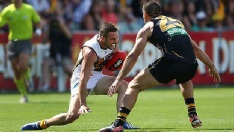A sprained ankle ligament occurs when the foot is twisted
severely, usually turning inwards under the leg, either when turning suddenly or landing on uneven ground.
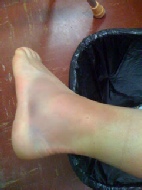 There is often severe pain, immediate swelling and variable amounts of bruising.
There is often severe pain, immediate swelling and variable amounts of bruising.
If pain on walking or putting weight on the foot persists an X-Ray may be needed to exclude a fracture.
Repeated sprains of the ankles may lead to joint instability and poor balance and co-ordination. Exercises to prevent this should be included in the rehab programme.
Treatment can be provided by contacting us and includes
- RICE Regime
- Proprioceptive support taping / strapping
- Relative rest / reduced activity
- Functional Rehab: jumping, turning, ball drills
- Balance Board exercises
- Calf strengthening
- Progressive jogging / running / jumping / kicking
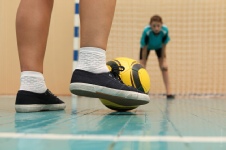
The Anterior Cruciate Ligament is a key stabiliser of the knee joint.
It prevents the knee from bending backwards (hyper-extension) and from bending sideways to the inside too far.
Injury to this ligament is very common in sports that require a lot of pivoting on one leg while changing direction, or where direct contact forces the knee backwards or inwards.
Female athletes are much more at risk of injury when playing or competing at the same level / intensity as their male peers. This is due to the differences in anatomy - the increased inward slope of the thigh bones making females more ‘knock kneed’.
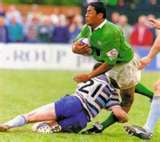
If the ACL is ruptured it leaves the knee unstable and exposes other tissues to increased risk of injury too. It is common to surgically reconstruct the ACL
A long period of Rehabilitation is required afterwards. The rehab period aims to:
- Restore normal Range of Movement to the knee
- Restore normal strength to the muscles around the knee and throughout the lower limb
- Restore good balance and co-ordination during movement
- Maximise muscle balance and motor control during sport specific activities
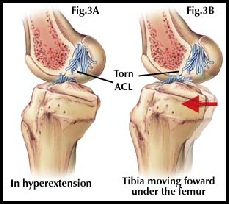
A post operative protocol will have goals the athlete can progress through before progressing to the next phase. Rehab may progress at different rates. Professional players could expect to return to full sports activity within a six month whereas amateurs are likely to be slower - maybe up to 12 months.
The phases of recovery are broadly summarised as:
- Recovery of range of movement (ROM), normal muscle activity and control of swelling
- Recovery of balance, control and joint position sense
- Recovery of functional movement in weightbearing, walking, jogging and running in straight line
- Exercise against resistance
- Sport specific activities - no contact
- Sport Specific activities - full contact
During the early phases of rehab the opportunity may be taken to work on other parts of the body needing attention i.e. upper body strengthening, core stability
Shoulder dislocation is a common traumatic injury which can occur during sporting activity or simply as a result of a fall.
A dislocated shoulder occurs when the head of the arm bone separates from the shoulder blade at the shoulder joint. The shoulder joint has great mobility but consequently little stability and is susceptible to dislocation. A subluxation is a partial dislocation of the shoulder.
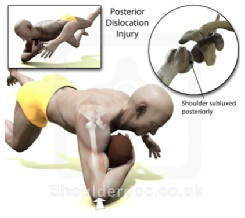
There are different types of dislocation
- 95% are forward - usually caused by a direct blow or a fall backwards or sideways onto an outstretched arm.
- Backward dislocations occur due to seizure or by strength imbalance of the rotator cuff muscles.
- Downward dislocation is very unlikely (<1%).
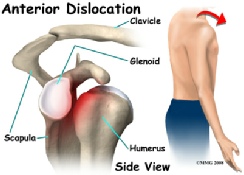
Signs and symptoms
- Significant pain
- Inability to move the arm
- Numbness of the arm
- Visibly displaced shoulder / flattened appearance around the shoulder.
Treatments
Prompt medical treatment should be sought for any dislocation injury to return the shoulder to its normal position.
x-ray will confirm the joint has been replaced into the joint.
Rest in a sling for several days until pain subsides
Mobilise joint soon as the pain allows.
Rotator cuff and deltoid muscle strengthening.
Trauma associated with dislocation disturbs normal activity of muscles around the shoulder blade.
First-time traumatic dislocation have a high rate of labral injury
Surgery may be required following repeated dislocation.
Return to full function and early return to sport or work can be facilitated following treatment and advice from Ennis Physiotherapy Clinic.
Shoulder Dislocation
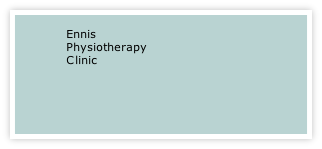




Mon - Fri 9.30am - 8.30pm


3A Barrack Close, Barrack St., Ennis, Co. Clare V95 X437

065 6840757
| Health+Safety Services |
| Sports Clubs+Teams Services |
| Standing Posture |
| Sitting Posture |
| Childhood Posture |
| Using Portable Devices |
| Normal Walking |
| Running |
| Running Drills Videos |
| Muscle Energetics |
| General Fitness |
| Losing Body Weight |
| Gaining Body Weight |
| Weight Loss Programmes |
| Start to Run |
| Start to Swim |
| Start Cycling |
| Start Nordic Waliking |
| Rehab of Tensdons |
| Loading of Tendons |
| Non Specific LBP |
| Posture |
| Intervertebral Disc |
| LBP Treatment |
| Non Specific Neck Pain |
| Neck Care Advice |
| Hamstring Strain |
| Ankle Sprain |
| ACL Injury |
| Joint Replacement |
| Shoulder Dislocation |
| Tennis Elbow |
| Wrist fracture |
| Fractured Knuckle |
| Selecting a Racquet |
| Racquet Grip Size |
| Racuet Sport Injuries |
| Training for Racquet Sports |
| Ski + Board Injuries |
| Injury Videos |
| Injury Prevention |
| Preventing Injury in Musicians |
| Irish Dancing |
| Preventing Dance Injury |
